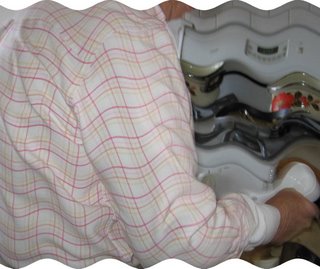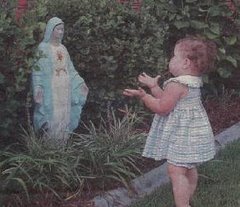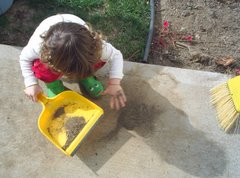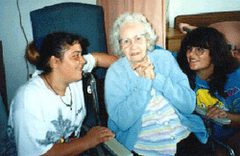I'd like to know if the problems of yesterday's religious education still exist in Catholic parochial schools and CCD programs. Comments from parents of or students in Catholic schools are solicited. From my own experiences of many years ago, here are examples of Catholic religious education during several time periods.
1950's--Grade school religion was taught using the Baltimore Catechisms and a small volume that summarized the Old and New Testaments. Our pastor would come into the classroom and ask us questions that we had to answer using what had been taught by the nuns (who he once noted were NOT very good theologians).
One question that I particularly remember was, "Can God make a circle that isn't round, or that has an endpoint?" We kids stumbled around, some saying yes and some saying no. We knew God could do all things--every power was His--yet we couldn't imagine His creating a circle of such a difficult to conceive nature. Our pastor finally told us that God could not create a lie, and the contradiction of an unround circle with an endpoint was a lie. If God lied, then He would violate His truthfulness and goodness and that was impossible. It was a very good discussion of the power of God.
During high school religion classes, we used a more advanced version of the St. Joseph Baltimore Catechism, but mostly studied Catholic history using a book written by a Fr. John Laux. Better histories have been written, but this was a good book for Catholic students in the 1950's. More importantly, the assistant pastor who taught religion talked to us personally. I remember when he asked if I was going to attend a public university, and when I said 'yes,' he was very disappointed. He then told me that "Excellent Catholics who attend a public university will become good Catholics, good Catholics will become fair, fair Catholics will become poor, and poor Catholics will become no Catholics at all."
When our assistant pastor said this, I resolved not to let it happen to me. I tried to attend daily Mass at 6:30 am while in college. A very good decision, because my husband says that is a big reason why he married me! Both of us also attended religion classes sponsored by the Catholic church and the Newman Club.
1960's--After Vatican II, I taught CCD to public school students in the middle grades. By the second half of the 60's, the religious education programs were becoming quite deficient and even very misleading. One Saturday, I was told to bring my fourth grade students to see a video presentation, "This Sunday Party," written and produced by a priest, Robert Hovda, of the Fargo diocese who was then working in Washington, DC with the National Liturgical Conference, a radical and very active Catholic organization during the 1960's.
It is informative to know more about this renegade priest who spearheaded much of the work of the NLC--so let's digress a little bit. Please note that in 1964, the National Liturgical Conference meeting in St. Louis celebrated the first official high Mass said in English in the U.S. Catholic Church.
The National Liturgical Conference continued to hold large annual conventions around the U.S during the 1960's. One convention was held in Kansas City, MO on August 21-24, 1967. Several small Catholic newspapers and magazines (introduced to me by my adoptive Godmother) had begun to pick up on the craziness of the time, and I became quite interested in what the NLC organizers were going to do at the Kansas City convention which was held in the Municipal Auditorium.
Because I had morning sickness (that was particularly bad in the evening!), I asked my husband to attend the advertised "Mass of the Future" after he left work. He came home and described four screens mounted at the four ends of the large arena. My husband said the offertory of the "Mass of the Future" featured a ping pong ball bouncing from one screen to the next--all around the arena. Many other bad things occurred from what my friends told me, and Bishop Hallinan's address made things worse by saying the Bishops "can prod those who are indifferent to the changes [of Vatican II], a more important task than curbing those whose enthusiasms outdistance their experience and skill." A good review of Hallinan's speech is also given by Adoremus.
The following year (1968), the annual convention was held in Washington, DC and it was W_ I_L_D! Check out the button ticket needed to enter the convention. One year later, Wikipedia reports that the first “rock mass” was produced, "featuring Minnie Ripperton and the Rotary Connection, at the Liturgical Conference National Convention, Milwaukee Arena, Milwaukee, WI, 1969, with thousands attending." The Wanderer newspaper sent a reporter to cover the convention, but nothing was printed in this orthodox Catholic newspaper. The editor explained that the convention "Mass" was sacrilegious and they could not describe it without sinning. [Much more information about the liturgical power of the NLC, its connection with ICEL, and its genesis of the English Mass is found in this article written by Michael Davies, the modern historian to whom I owe so much for a good understanding of what happened before, during, and after Vatican II.]
Now back to Hovda's slide show and my CCD class. The slide show taught the children that in the Mass, "we eat the bread and drink the wine"--which is exactly what one of my students answered when the assistant pastor asked the class what they had just learned. The young priest quickly responded, "No, no! In the Mass, we eat Christ's Body and drink His blood under the forms of bread and wine." I will never forget the puzzled and disappointed face of the young girl who had answered truthfully what she had heard and seen in the Hovda slide show. Later I asked the assistant pastor to withdraw the slide show from future use, but he made some excuse that it must still be shown to the students.
Early 1970's--Our own children were in Catholic grade school and learned very little about their faith from the new and very deficient catechisms. Even the religious songs were bad. I confronted one nun who was teaching my children a song with words that were heretical. I asked her to explain why she used religious songs. She suddenly realized her answer, that songs were repetitive means used to more effectively teach students the faith, was self-condemning.
One of the last straws was the introduction of the "Becoming a Person" program in the Catholic grade school. This objectionable sex education program was likely related to the 1961 book by Carl Rogers, On Becoming a Person. Many parents objected, and so the program was allowed to be 'voluntary', with children allowed to be excused if the parents insisted. My husband and I did insist, yet within a couple of weeks, the principal called to apologize because our children had been "accidentally left in the classroom" when the "Becoming a Person" sex education program was taught.
About this time I toured the classrooms during teacher-parent conferences and found some of the displays quite unsuitable, unworthy of a Catholic bulletin board, and even objectionable. One that I particularly remember was of the stations of the cross. It had been changed. Now the image of the fall of Jesus as he carried his cross up Calvary was pictured as the beating of a black person by a white police officer.
In short, we found our situation in the typical Catholic school of the early 1970's more than a challenge--it was a spiritual disaster. We moved (another story), and this decision was the best we could have ever made to save our souls and the souls of our children.
Daily Rome Shot 1516
7 hours ago









7 comments:
I really like your posts where you talk about what Catholic life was like back then...thank you!
My husband and I taught CCD in our parish a few years back. They are using the Faith and Life Series. The pictures are wonderful. The text is good.
One book that I do want to mention is the Little Catechism on the Eucharist by Fr. Roberto Coggi. It is a great First Communion prep with The Baltimore Catechism. It explains some difficult concepts like transubstantiation on a child's level.
Don't stop at the 70s... the 80s were a treat too!
I actually blogged about what I wasn't taught at CCD vs. what I did learn.
Mostly, what I learned was how to make felt banners (we made lots, and lots of banners) so I titled my post - Felt banner Catholicicm
I don't think, from my outsider investigations, that Catholic education has been perfected lately, or even greatly improved in general. But there are pockets now, where you can find some excellent instruction. If I were going to put my children in a Catholic elementary, they would go to St. Andrew the Apostle Parish in Gladstone, even though we aren't local to that parish. But my children will attend our local parishes over my dead body. It just depends, sadly, on where you look and how far you are willing to drive.
This could be a magazine article
Mary Martha,
Your post on "Felt Banner Catholicism" was great! Thanks for recommending it. Very, very funny, although the subject makes me want to cry at the loss of so many souls due to lack of good religious instruction during the 70's, 80's, and 90's.
Alison,
Thanks for the recommendation on Fr. Coggi's catechism. That's what I was looking for--some personal experience from knowledgeable individuals on what is going on in Catholic schools at the present time.
Daisy,
St. Andrew the Apostle School in the Northland is an exception to mostly declining Catholic school populations around Greater Kansas City. Classrooms and students are being added, not subtracted! Undoubtedly it is due to their fine pastor and to the nuns in brown habits who teach in the school. I also understand the catechisms and religious education are much, much better than in the days of "Felt Banner Catholicism".
When my son was getting ready for his First Holy Communion, he did not attend a parochial school. The priest at that parish insisted he attend CCD for the year prior to his FHC. I don't remember what series they used, but I knew enough to know it was not good. I taught him from the Baltimore Catechism at home. When he went to CDD, it was fun to watch him - he knew more than the teacher! When my daughter was getting ready for her FHC, we were at a different parish, and she was attending the parish school. The school did use Faith & Life, which I had heard was good. I did not think I needed to back up what was being taught at a parish school (the parish being conservative) that was using a good series. Unfortunately, I was wrong. She does not have the grasp on her faith that her brother does. I wish I could get those years back. Just because the parish is conservative, and the series is good, does not mean that religion will be taught properly. Parents must be vigilant, and not leave to chance anything that may affect the souls of their children. Never assume.
Post a Comment